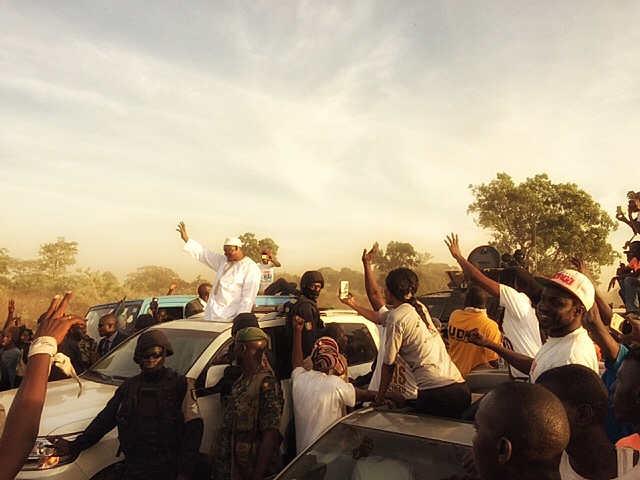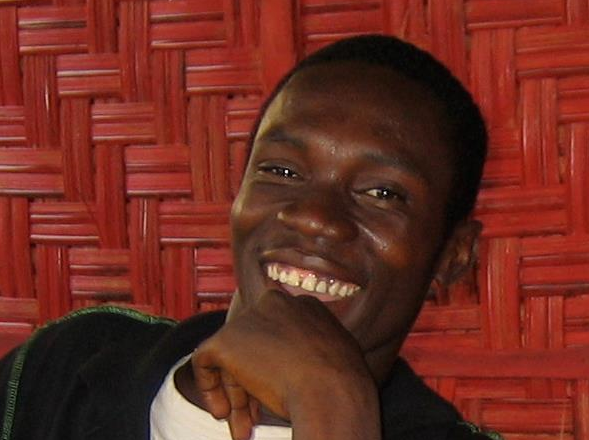The dry season’s dust has again settled on Conakry’s streets, aside from a few marks of ashes and rubble on the sides of the main avenues, everything seems to be back to the bustling normal. Just about ten days ago, things looked quite different in the Guinean capital. On February 20th, a nation-wide general strike in the education sector culminated in violent demonstrations, which took the government by surprise. Seven people were shot dead by state forces, thirty were injured and a dozen arrested, numerous vehicles were burnt, and a gas station and a police commissariat were pillaged. Though Conakry has experienced plenty of similar events during the past decade, there are a number of reasons not to write this off as simply another instance of urban violence. Continue reading
AuthorMats Utas

President Adama Barrow greeting the people. Photo by Katarina Höije
It finally became clear on January 21, 2017, that Yahya Jammeh, the long-serving autocratic president of The Gambia would step down and leave the country. The road to this point was a twisty one. Jammeh had lost the December 1, 2016, election to Adama Barrow (who represented a coalition of opposition parties). Although Jammeh, much to everyone’s surprise, initially conceded the election he quickly reverted to form and suggested that the election was not valid and called for a new one to be held–a position rejected by the opposition and the international community. Most notably, the Economic Community of West African States (ECOWAS) took a firm line and recognized Barrow as the legitimate president and suggested that they might use military force to oust Jammeh. As negotiations between the parties remained inconclusive,arrow and his associates travelled to Senegal where, on January 19 he took the oath of office at the Gambian High Commission in Dakar. Meanwhile, ECOWAS forces, consisting primarily of Senegalese troops with Nigerian air and naval backing, mobilized to enforce the election results. After a tense period that saw ECOWAS forces briefly enter the country only to pull back, Gambians–and West Africans–could breath a sigh of relief as the by now completely isolated Jammeh agreed to go into exile with not a drop of blood shed. In the evening of January 21, Jammeh boarded a plane for Equatorial Guinea. Continue reading
During the second part of this spring sociologist Ugo Corte and I will teach a new master course in the Ethnography of the senses here at Uppsala University. I have over the last few years tried to encourage students in both using other technologies during fieldwork and also opening up for other outputs than the traditional essay. One student who took the challenge was David, at the time a BA student at the department, who went to Malta for a workshop in Graphic Anthropology. Here is his take on graphic anthropology.
Familiar with Graphic Anthropology? Didn’t think so… Neither was I before I was forwarded an e-mail for an upcoming workshop on Malta(!) last March. It turned out that some sort of renaissance in the ways of using fieldnotes accompanied by drawings was taking place. At least as a part of doing participatory observations in fieldwork and as one method of Visual Anthropology. Not knowing where it would eventually take me I started filling out the workshop’s application online… Continue reading

Empty Ebola Treatment Center at ELWA outside Monrovia. November 1, 2016
Passage from a medical journal from 1982: The results seem to indicate that at least Liberia and Guinea have been included in the Ebola and Marburg virus endemic zone. Therefore, the medical personnel in Liberian health centres should be aware of the possibility that they may come across active cases and thus be prepared to avoid nosocomial epidemics.
Signs here and there in the city remind us of the recent Ebola crisis. An empty bucket outside a shop, hand sanitizer in the fancier restaurants, but not much more. Monrovians do not mention it much, unless you ask. It is not like the previous civil wars which people still like to refer to. If Ebola in Liberia was like a silent war, it also appears to have a silent aftermath. Riding a shared taxi I ask my co-passengers about this. Why do you keep talking about the war, that took place so long ago but not the Ebola crisis? A woman answers: the Ebola epidemic was simply too fearful. In the war you would know where the enemy came from, Ebola on the other hand came from nowhere and everywhere; it was an invisible enemy. Which one would they prefer? The war, is the unison answer amongst fellow passengers. And when I did not stress it anymore we quickly moved into other less ‘fearful’ topics. Continue reading
Ebola: How a People’s Science Helped End an Epidemic is one of the first books to provide an in-depth analysis of the recent pandemic in West Africa, The author Paul Richards has done an excellent job in bringing to the fore community efforts in responding to the virus. Continue reading
One of Charles Taylor’s best known and most eloquent defenders is John T. Richardson, a Liberian architect, who continues to speak with the former Liberian President two to three times a week. Richardson, an American trained architect who launched his career in the 1970s, winning contracts from the African Development Bank, USAID, and the World Bank to construct rural schools and hospitals across Liberia, became an international pariah several decades later when he was placed on a UN travel ban during the last years of the Taylor administration, which he served in various capacities.
Today, Richardson operates from a cramped but well decorated office in a gated compound just off Tubman Boulevard, the main thoroughfare of Monrovia. His father, Nathaniel Richardson, was one of Liberia’s greatest historians of the era when the country was dominated by the True Whig Party (TWP) and the descendants of black American immigrants (in which both Taylor and Richardson have their roots). Although the younger Richardson states, “I have no ambitions politically” he came, as a result of a self-described humanitarian impulse, to play a major role in the calamitous struggle to shape post TWP Liberia, serving as a loyal adviser to Taylor throughout Liberia’s 14 years of armed conflict. Continue reading
 It’s raining in Freetown and the traffic is, as usual, slow on the road through Congo Town towards Kroo Town Road. The radio announcer is going through the obituaries in a solemn, deliberate monotone, the names different, the pattern the same: Mr John Koroma of Kissy Town passed away on said date leaving said relatives in said location… repeat… repeat… repeat. Variations on the theme. After a few minutes of death reports the obituaries are rounded off with a few snatches of Abide With Me, by which time we have actually reached Kroo Town Road. We swing right on the now tarmacked road that runs parallel to Adelaide Street and pass what, ten years ago, was the Pentagon car wash, a hangout for ex-combatants and others struggling to make a living in a world of ‘no war no peace’ under conditions that one of them described as ‘exorbitant poverty’.
It’s raining in Freetown and the traffic is, as usual, slow on the road through Congo Town towards Kroo Town Road. The radio announcer is going through the obituaries in a solemn, deliberate monotone, the names different, the pattern the same: Mr John Koroma of Kissy Town passed away on said date leaving said relatives in said location… repeat… repeat… repeat. Variations on the theme. After a few minutes of death reports the obituaries are rounded off with a few snatches of Abide With Me, by which time we have actually reached Kroo Town Road. We swing right on the now tarmacked road that runs parallel to Adelaide Street and pass what, ten years ago, was the Pentagon car wash, a hangout for ex-combatants and others struggling to make a living in a world of ‘no war no peace’ under conditions that one of them described as ‘exorbitant poverty’.
I’m heading for the office of Prison Watch (a local human rights NGO) on Gabriel Street at the other end of the road but it was Pentagon that was my first point of reference in Sierra Leone. It was there my encounters with marginal, hustling youth began (thanks to Mats Utas!). And it was not far from there that I first encountered Flavour. Continue reading
Thierno Hamidou Diallo, may he rest in peace, was fatally shot on August 16th, 2016. He is the tragic victim of the anti-government demonstration in the Guinean capital Conakry, which he had nothing to do with. The 21-year old man was hanging out the laundry to dry on a balcony when the bullet hit him.
Until then, it had been the most peaceful anti-government demonstration that one could imagine, and probably the first after which the Guinean opposition and the Guinean government congratulated one another for “the discipline and professionalism of the security forces“ (opposition leader Cellou Diallo) and for having successfully taken “another step in our democratic advancement” (government spokesperson Albert Damantang).
About half a million people had attended the political rally at the central stadium, the atmosphere was hopeful, and when the rally was over, the great majority went back to their homes in peace. Continue reading
The most challenging notion to take on board in the governance of today’s world is that not all that counts can be counted. We increasingly rely on numbers as shortcuts to information about the world that we do not have time to digest.
The name of the game is governance “as if” the world counts. It might be a smart shortcut sometimes, but we are in deep trouble if we forget that we are doing it “as if” the world counts. Leadership should take making good decisions seriously. If the method by which we get knowledge and the method by which we make decisions is limited to what can be numbered, we are setting up a system of governance that’s systematically getting stuff that actually counts wrong. Continue reading
At the 27th African Union Summit held in Kigali, Rwanda, member states adopted a new funding model. The proposal by Dr Donald Kaberuka to institute an import levy of 0,2% on ‘eligible’ imports’ is widely hailed as a historic step forward for the organization and its ambitions to become independent and self-reliant. If implemented as expected, the Kaberuka model will fund the AU general budget and its programmes and is expected to raise approximately USD 1,2 billion beginning in 2017. Starting in 2017, each of the continent’s regions have committed to paying USD 65 m into the AU Peace Fund, which will enable Africa to fund 25% of the costs of AU peace operations. While this decision is imperative, I would like in this article to reflect on some of the broader challenges and trends in Africa’s security governance.
© 2024 Mats Utas
Theme by Anders Norén — Up ↑